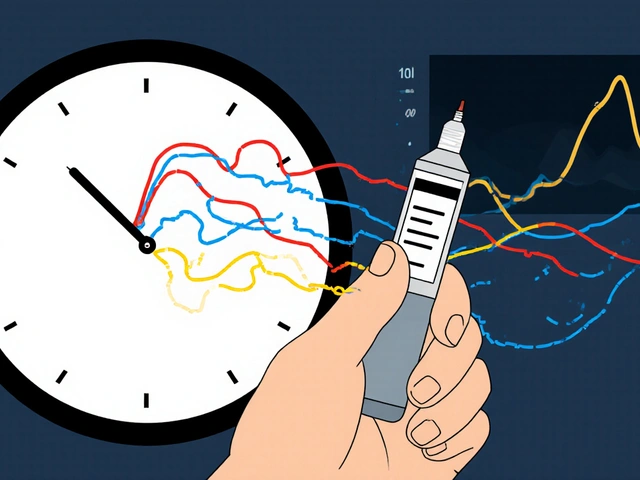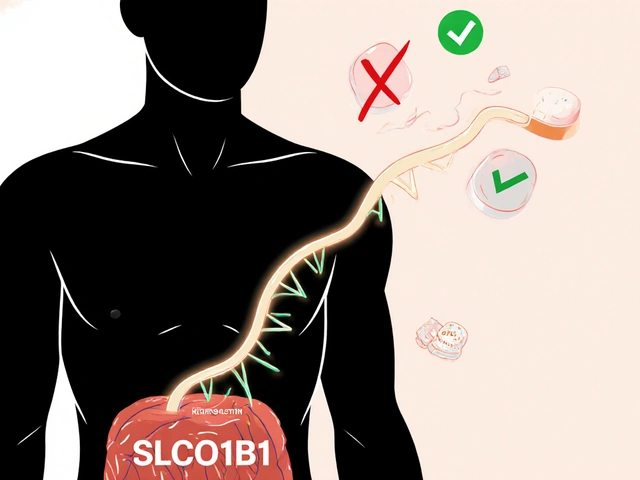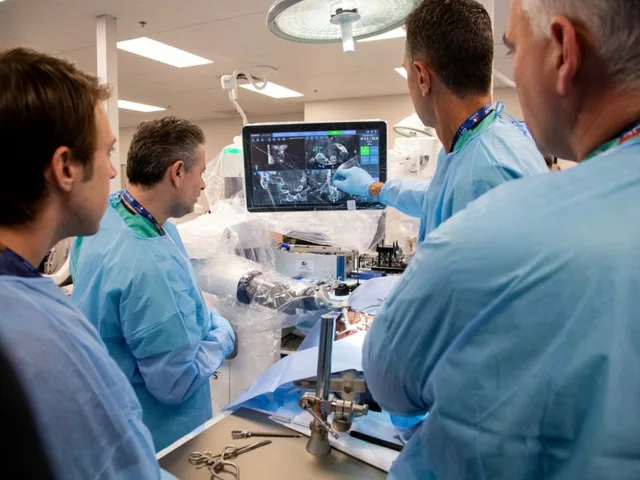The Science Behind Amiodarone: A Comprehensive Guide for Healthcare Professionals

- Colin Hurd
- 1 July 2023
- 11 Comments
Understanding the Basics of Amiodarone
As a healthcare professional, it’s crucial to understand the science behind the medications we administer. One such drug that plays an important role in cardiac care is Amiodarone. This medication, classified as an antiarrhythmic, is often used to treat life-threatening heart rhythm problems. While its efficacy is undoubted, it's equally critical to understand its mechanism of action, benefits, and potential side effects. This way, we can ensure that we are providing the best possible care to our patients.
History and Development of Amiodarone
The journey of Amiodarone is quite interesting. First developed in the 1960s, it was initially overlooked due to its potential side effects. However, it was later rediscovered and gained popularity in the 1980s as a potent antiarrhythmic drug. It's fascinating how medical science evolves, and how a once-shunned medication can become a life-saving treatment. Despite its side effects, when used appropriately, Amiodarone can dramatically improve a patient's quality of life.
Mechanism of Action
Amiodarone is a Class III antiarrhythmic, meaning it primarily works by blocking potassium channels in the heart cells. This delays repolarization and prolongs the action potential, thus stabilizing the heart rhythm. However, Amiodarone is unique among its class as it also has Class I, II, and IV activities, making it a broad-spectrum antiarrhythmic drug. Understanding this mechanism of action helps us appreciate the science behind this potent medication.
Indications for Usage
Amiodarone is primarily indicated for the management of severe rhythm disorders such as ventricular tachycardia and fibrillation, and certain types of supraventricular tachycardias. It's also used for prophylaxis in patients at high risk of sudden cardiac death. Understanding these indications is vital in making informed decisions about patient care, ensuring that the right drug is given to the right patient at the right time.
Benefits of Amiodarone
Amiodarone's broad-spectrum activity makes it a versatile tool in managing various cardiac arrhythmias. It has shown to be effective where other antiarrhythmics have failed, making it a valuable asset in treating refractory cases. Furthermore, its prophylactic use can help prevent life-threatening arrhythmias in high-risk patients, potentially saving lives before a critical event occurs.
Potential Side Effects
Like any other medication, Amiodarone is not without side effects. Some of these include nausea, fatigue, and tremors, which are often manageable. However, it can also lead to more serious effects such as lung or liver damage, thyroid dysfunction, and even vision problems. As healthcare professionals, it's our responsibility to monitor for these side effects and manage them promptly and effectively.
Drug Interactions
Amiodarone has a wide range of drug interactions due to its extensive metabolism and elimination pathways. It can interact with various classes of drugs, including other antiarrhythmics, anticoagulants, and even certain antibiotics. Understanding these interactions is crucial to prevent adverse effects and to ensure the safety of our patients.
Monitoring and Follow-up
Given its side effects and drug interactions, patients on Amiodarone require careful monitoring and follow-up. This includes regular check-ups, blood tests, and even imaging studies to detect any potential complications. As healthcare professionals, we should be proactive in scheduling these follow-ups and educating our patients about the importance of regular monitoring.
Conclusion: The Science of Saving Lives
In conclusion, the science behind Amiodarone is a testament to the ever-evolving nature of medical science. Despite its potential side effects, it remains a powerful tool in our arsenal against life-threatening cardiac arrhythmias. As healthcare professionals, understanding the science behind such medications allows us to provide the best possible care to our patients, ultimately saving lives.




Comments
Sean Lee
Amidst the labyrinthine circuitry of cardiac electrophysiology, amiodarone emerges as a polypharmacological chameleon, modulating ion flux across myocardial membranes with a potency that borders on the ontological. Its Class III designation underscores a primary affinity for potassium channel blockade, yet the drug's pleiotropic interactions with sodium, calcium, and β‑adrenergic pathways render it a veritable Swiss‑army knife of antiarrhythmic therapy. The pharmacokinetic inertia-characterized by an extensive half‑life spanning weeks-is both a therapeutic boon and a pharmacovigilance challenge, necessitating a nuanced risk‑benefit calculus. Moreover, the lipophilic reservoir effect, sequestering the molecule within adipose tissue, contributes to delayed onset of adverse sequelae, such as pulmonary fibrosis or thyrotoxic storm. Understanding these mechanistic underpinnings is indispensable for any clinician who aspires to wield amiodarone with epistemic humility.
July 1, 2023 AT 21:17
Michael Christian
Honestly, this rundown is super useful – it breaks down the scary stuff into bite‑size pieces. Remember to keep an eye on thyroid labs and liver enzymes; catching a shift early can save a lot of hassle. Also, patient education goes a long way: let them know why those routine blood draws matter. Stay positive, stay proactive, and you’ll keep those arrhythmias in check.
July 2, 2023 AT 05:37
Steven Elliott
Oh sure, another miracle drug that saves lives but comes with a side‑effect list longer than a grocery receipt. Anyone ever actually read the fine print, or do we just nod and prescribe because the textbooks say so? Guess we’ll keep pulling the trigger and hope the patient doesn’t develop a rash that looks like a UFO landing.
July 2, 2023 AT 13:57
Lawrence D. Law
Esteemed Colleagues,; it is incumbent upon us, as custodians of cardiology, to rigorously appraise the therapeutic index of amiodarone; indeed, its efficacy in ventricular tachyarrhythmias is indisputable; however, the attendant risks – pulmonary toxicity, hepatic derangement, ophthalmologic disturbances – demand vigilant surveillance; let us, therefore, adopt a protocolized monitoring schedule, replete with baseline and periodic pulmonary function tests, thyroid panels, and hepatic panels; adherence to such a regimen shall mitigate iatrogenic morbidity.
July 2, 2023 AT 22:17
Mary K
Picture this: a drug that dances across the heart’s rhythm like a seasoned ballerina, yet sometimes trips over its own shoes. Amiodarone can be that hero when the usual meds throw in the towel, but it also carries a colorful palette of side‑effects – think of it as a fireworks show in the body. Keep the conversation bright and honest with patients, and you’ll turn that apprehension into empowerment. Let’s keep the momentum, celebrate the wins, and tweak the plan when the spark starts to fizzle.
July 3, 2023 AT 06:37
Odin Zifer
People think amiodarone is just another pill but what they don’t see is the hidden agenda behind the pharma giants pushing it on us they want us dependent on their drug supply while they control the narrative about safety and efficacy you look at the reports about lung damage and thyroid issues and you realize it’s a systematic cover up hidden in medical journals and the watchdog agencies are either paid off or too scared to speak up we need to wake up and question why this drug stays on the market despite the red flags
July 3, 2023 AT 14:57
Marisa Leighton
Wow, what a deep dive into amiodarone – it feels like we just unpacked an entire saga of cardiac care, complete with heroes, villains, and unexpected plot twists! First, the sheer versatility of this molecule is awe‑inspiring; it can calm a raging ventricular tachycardia one moment and then, if we’re not careful, whisper warnings of pulmonary fibrosis the next. The pharmacodynamics are practically a lesson in electrophysiology, reminding us that every ion channel blocked is a step toward stability, but also a reminder of the delicate balance we must maintain. I love how the article emphasizes proactive monitoring – regular thyroid panels, liver enzymes, and chest imaging are not just bureaucratic hoops, they’re our safety net. It’s also crucial to involve patients in the conversation; when they understand why we schedule those blood draws, compliance skyrockets. Let’s not forget the psychological aspect – patients on amiodarone often feel a mixture of relief and anxiety, and our empathy can turn that anxiety into confidence. Remember, the drug’s long half‑life means effects linger, so any side‑effect we catch early can prevent a cascade of complications. I’ve seen cases where early detection of a modest rise in TSH prevented full‑blown hypothyroidism, and that’s a win worth celebrating. Keep a checklist handy, share it with your nursing team, and make it part of the discharge plan. And if you’re ever in doubt, don’t hesitate to consult electrophysiology; a second opinion can save a life. Finally, stay curious: research is constantly evolving, and tomorrow’s guidelines might tweak the dosing schedule or introduce novel monitoring modalities. Embrace the science, champion the patient, and let the rhythm of care beat strong!
July 3, 2023 AT 23:17
Brennan Keeler
Look, amiod arone is not some back‑up otion – it’s a first‑line weapon when arrhythmias get out of hand. The potassium channel block is just the tip of the iceberg; it also modulates IKr, INa, and even beta‑receptor activity – a real multitasker. Sure, you’ll hear the usual warnings about lung and thyroid toxicity, but if you monitor LFTs, PFTs, and TSHs on schedule, the risk is manageable. Don’t let the hype about newer agents distract you – many of those lack the broad‑spectrum power that amiodarone delivers. Stay vigilant, stay aggressive, and keep the dosage as low as you can tolerate.
July 4, 2023 AT 07:37
Chelsea Hackbarth
Great summary – love the detail! 😊
July 4, 2023 AT 15:57
Adam Shooter
While the foregoing exposition admirably aggregates the canonical tenets of amiodarone pharmacotherapy, it regrettably glosses over the epistemic lacunae that pervade contemporary clinical praxis. The discourse fails to interrogate the methodological robustness of seminal trials, thereby perpetuating a veneer of evidentiary certainty that is, at best, tenuous. Moreover, the cavalier endorsement of routine monitoring protocols betrays a complacency that obfuscates the nuanced inter‑patient variability intrinsic to pharmacokinetic reservoirs. A more rigorous meta‑analytic synthesis, stratified by comorbidity burden and genomic polymorphisms, is requisite to distill actionable insights. In the absence of such granularity, clinicians are left navigating a stochastic landscape with an overreliance on heuristics that may exacerbate iatrogenic sequelae. The onus, therefore, rests upon the scholarly community to recalibrate its investigational compass and to promulgate a paradigm shift from anecdotal praxis to data‑driven precision.
July 5, 2023 AT 00:17
Shanmughasundhar Sengeni
Honestly, the article is okay but feels like a textbook rewrite – not much fresh insight. You get the basics, the history, the side effects, but where’s the real-world hacks? Like, any tips on how to taper off safely or handle the weird skin discoloration some patients get? A few practical nuggets would have made it more useful.
July 5, 2023 AT 08:37